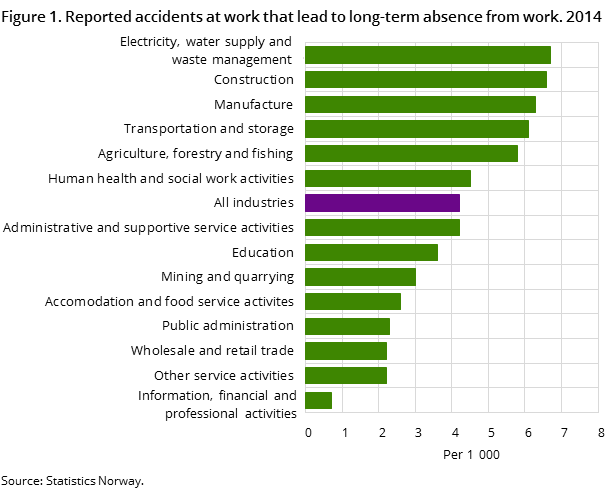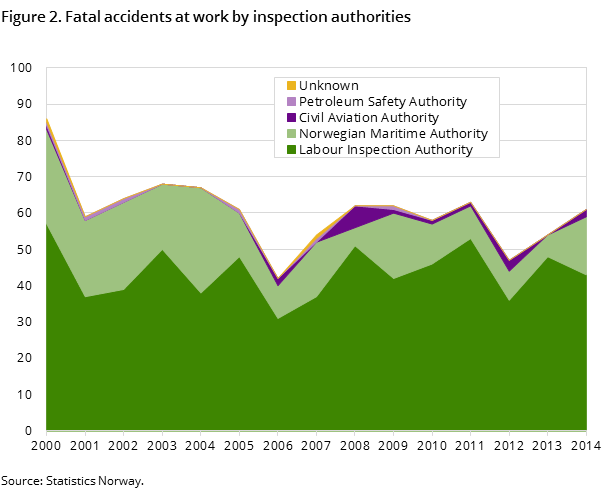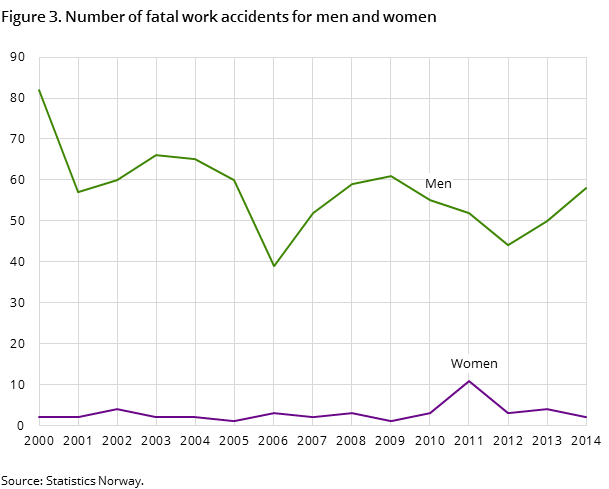Content
Published:
This is an archived release.
Fatal accidents: more than 9 in 10 are men
In 2014, NAV received reports of 24 000 accidents at work. Sixty per cent of the accidents led to absence from work of three days or less, and 40 per cent led to absences of more than three days. In total, 61 fatal accidents were reported in 2014, and 58 of the deceased were men.
| 2014 | ||
|---|---|---|
| Accidents at work per 1 000 employees. Long-term absence1 | Number of fatal accidents at work | |
| 1Long term absence: 'Likely to entail absence of more than three days' | ||
| Electricity, water supply, sewerage, waste management | 6.7 | 0 |
| Construction | 6.6 | 11 |
| Manufacture | 6.3 | 6 |
| Transportation and storage | 6.1 | 12 |
| Agriculture, forestry and fishing | 5.8 | 22 |
| All industries | 4.2 | 61 |



This is the first time Statistics Norway has released statistics on accidents at work in Norway. The statistics show accidents at work with a breakdown for men and women, different age groups and industries. Note that accidents at work are given as a rate of accidents per 1 000 employees . Fatal accidents at work are reported as the real count.
Blue-collar industries have more accidents with long-term absence
Five industry groups reported more than 5.5 accidents per 1 000 employees that led to absence from work that lasted more than three days (long-term absence). The five industries are Electricity, water supply and waste management, Construction, Manufacture, Transportation and storage and Agriculture forestry and fishing. This might not be so surprising considering the fact that these industries have a relatively high degree of manual labour, often involving the use of heavy machinery. By contrast, the industry Information, financial and professional activities reported less than 1 work accident per 1 000 employees that led to long-term absence.
Health and social services have more accidents with short-term absence
Health and social services reported most accidents at work that led to short-term absence compared to other industries. In 2014, this industry reported 9 accidents per 1 000 employees, Electricity, water supply and sewage reported 8.7 and Manufacture and Education both reported 8.1.
The average for all industries was 5.8. Different reporting policies might be one reason for differences between industries, especially when it comes to short-term absence.
Fatal accidents: 7 in 10 reports made to Labour Inspection Authority
The largest share of fatal accidents are reported to the Labour Inspection Authority; almost 70 per cent. About 25 per cent are reported to the Norwegian Maritime Authority. This means only a fraction is reported to the Civil Aviation Authority or the Petroleum Safety Authority.
Fatal accidents: more than 9 in 10 are men
Over the last 15 years, more than half of all fatal accidents were in Transportation and storage or the Primary Industries, with 484 fatal accidents in total. This is followed by Construction and Manufacture, with 118 and 83 respectively.
There is a large gender disparity in relation to fatal accidents; in 95 per cent of the cases the deceased is a man. This can be viewed in conjunction with the gender divide in the Norwegian labour market.
Gender divide in the labour market
There is a certain gender divide in the Norwegian labour market. While men are in the majority in industries such as Agriculture, forestry and fishing, Construction and Manufacture, women are in the majority in Health and social services and in Education. This gender divide is an important factor for understanding the distribution of accidents between men and women.
Occupational injury insuranceOpen and readClose
In order for an accident to be accepted by NAV as a work accident, the employee must be covered by occupational injury insurance. Occupational injury insurance is mandatory for employers, while the self-employed and freelancers are free to choose. In agriculture, forestry and fishing, a relatively high share is self-employed. The risk of accidents in this industry may be considered higher than in some other industries. These accidents will not be included in the statistics if the person does not have occupational injury insurance and thus does not report the accident to NAV.
New statistics on accidents at workOpen and readClose
Statistics Norway’s new statistics cover fatal accidents reported to four inspection authorities, as well as reports sent to NAV by employers in a given calendar year.
Contact
-
Øyvind Isachsen Berntsen
E-mail: oyvind.berntsen@ssb.no
tel.: (+47) 40 90 23 28
-
Arne Jensen
E-mail: arne.jensen@ssb.no
tel.: (+47) 99 71 22 45
